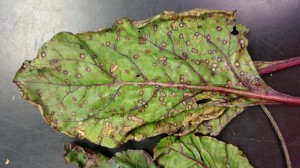Basil downy mildew remains active. The weather this time of year is ideal for downy mildew development across many crops. Growers should remain diligent going into the fall with regular scouting and preventative fungicide applications.
Cucurbit downy and powdery mildew remain active. Growers holding mature pumpkins in the field for the next few weeks should do their best to maintain the foliage for as long as possible to prevent potential sunscald injury. Late-season fungicide applications will also help keep powdery mildew off of the stems extending the pumpkin’s post-harvest longevity. Stems infected with powdery mildew will turn brown and dry out much quicker than healthier stems. Additionally, powdery mildew and downy mildew fungicide programs for all fall cucurbit crops should continue as along as harvesting continues.
There have been no new reports of Late blight this past week. Growers with late-season tomato plantings should be diligent and scout on a regular basis. The cooler weather and prolonged dew periods are ideal conditions for Late blight development. All old plantings should be sprayed with gramoxone to burn the foliage down or mowed/disced under as soon as possible after the last harvest.


